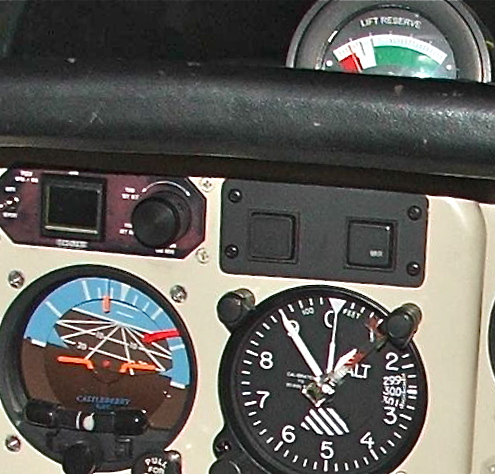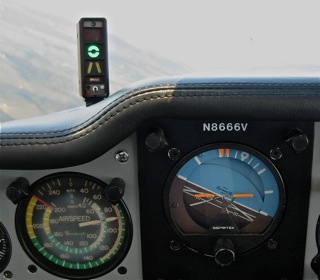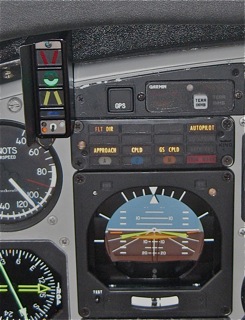We pilots here all use AoA in our light aircraft as a reliable early warning of impending stall and we see the AlphaSystems AoA as a very affordable product. None of us are military aviators and none believe we are a "hot stick." Skilled? Well-trained? Competent? I have flown with most of them and I'd say so.
Lance Fisher, Beech Baron owner, posted this at "BeechTalk"
“I have the"mechanical" gauge Alpha Systems AoA and I prefer that over the LED types and it's less expensive to boot.  Mine has the pneumatic gauge mounted so it's half-submerged in the glare shield directly in front of the pilot seat. Mine has the pneumatic gauge mounted so it's half-submerged in the glare shield directly in front of the pilot seat.
In an airplane like a Bonanza or Baron—which can operate over awide range of weights—one of the chief advantages of AoA is that the performance "speeds" like Vy, Vx, Vs, etc. occur at fixed AoA independent of weight or G-loading.….[Editor: and independent of Density Altitude, too.]
"One thing I found during some experimentation is that while the "stall speed" on the ASI varies greatly with power (more than 10 KIAS difference between idle and climb power) the AoA indication at stall is unaffected by thrust from the engines.
At first, I was surprised by this knowing that the reasons power affects stall speed involve disruption or enhancement of the airflow over the wings along with a smaller contribution of direct lift from the thrust when the nose is pointing upwards. But after seeing the consistency of AoA at stall over a wide range of power settings and thinking about it I concluded that while thrust can and does change the amount of lift being produced, that power change doesn't affect the stalling AoA and instead only affects AoA indirectly by virtue of the need to increase AoA to maintain the same lift when the power is reduced. So in summary: another advantage of AoA over the ASI is the ability to provide an indication of stall margin that's unaffected by engine power output."
Chuck Beavers flies a Bonanza G35, a lovely lady, indeed. He's been a VFR-only Private Pilot since 1980 with most of his ~1,000 hours in small tailwheel aircraft.
"Stepping up to the Bonanza was a bit intimidating at first but the AoA has really given me the peace of mind to fly the plane slowly. I LOVE my simple, reliable, and predictable AoA. I use it EVERY time I am in a flight regime that could be problematic. It is great for departures, approaches, slow flight, steep turns, and short field operations."
Just as Lance did, Chuck chose the simplest of all the systems and mounted the Alpha System mechanical display in  the upper left panel. With no connection whatsoever to the aircraft electrical system, it's VERY affordable and very easy to install. the upper left panel. With no connection whatsoever to the aircraft electrical system, it's VERY affordable and very easy to install.
Chuck continues: "I installed the AoA myself per the instructions provided and only needed to make one small calibration adjustment to the outside probe, because the reccomended probe angle was very close to optimal. I set the AoA probe so that the stall break would occur at the point where the indicator needle was one needle-width into the red zone.
"I conducted my calibration flights on a calm standard day by myself and stalled the plane in nearly every configuration I could think of. The mechanical system is SO SIMPLE and SO EASY to interpret! I became so much more comfortable in the approach to landing after only an hour of familiarization time flying the AoA needle into the yellow. An AoA will be 'required equipment' for any future airplane that I may own."
Sparky Imeson ran an air taxi service flying a Cessna 180 throughout the northwestern Rocky Mountain region. Many of his back-country mountain destinations were short strips at high altitudes with challenging approaches. Sparky was a FAA Accident Prevention Counselor since the program's inception in 1971; and three-time winner of the FAA Flight Instructor of the Year award for the Northwest Mountain Region. "Though I often set and maintain a given aircraft attitude for short-field approaches, cross-checked by the airspeed indicator, the true indication of how close an aircraft is to a stall is really the angle of attack. In my previous career, I flew a Cessna Citation X for 2,000 hours and learned firsthand the value of an angle of attack (AoA) indicator.
Joe Sasser retired from a long career as Chief Pilot of a corporate fleet; he's now a Beech V35B Bonanza owner:
"I encourage the use of AoA indicators in our Bonanzas and Barons and in any training aircraft.
"I first was introduced to flying aircraft with Angle Of Attack  indicators in the 1960's when we added them to a couple of King Airs that I was operating out of Chattanooga for a major oil company that had several other King Airs and Corporate Jets. The jets all had AoAs installed. The AoA was so much more useful than just IAS during ALL maneuvering for approach and landings, but especially so during non-precision and/or circling approaches or landing on short fields. Every corporate aircraft I operated since those early King Airs, either came with an AoA indicators or we soon added them. indicators in the 1960's when we added them to a couple of King Airs that I was operating out of Chattanooga for a major oil company that had several other King Airs and Corporate Jets. The jets all had AoAs installed. The AoA was so much more useful than just IAS during ALL maneuvering for approach and landings, but especially so during non-precision and/or circling approaches or landing on short fields. Every corporate aircraft I operated since those early King Airs, either came with an AoA indicators or we soon added them.
"I quickly learned there is no better way to "Fly The Wing" than always keeping the AoA indicator in your scan. That has held true for the first landing we ever made at Grundy Virginia with a 2400' runway at night in the King Air 200 or for the first landing we ever made at Almaty Kazakhstan in the Falcon 900EX at midnight with very tall mountains so close by.
"It is my opinion that, if understood and flown correctly, AoA will keep the pilot from an inadvertent stalling of the wing in the most common "stall, spin, crash" scenario that has happened, as we all know, to some of the best of pilots."
Jim Ford & Bruce Cochran are Westwind II crew members; they also fly a Cirrus SR22:
First, from Bruce: "The AoA in the Westwind is not considered a primary instrument according to the AFM. [Editor: the Westwind's AoA is a very expensive device.] Jim and I use the AoA primarily as a cross-check on the approach to landing, establishing optimum hold speeds and in the case of an engine out at altitude, the best drift down. Low altitude steep banks that result in a stall are normally a result of poor planning, poor airmanship, poor judgment, or trying to impress someone. There may be instances requiring an evasive maneuver requiring steep low altitude banks, but I believe this would be an extreme case of see and evade.
"Should an AoA be a part of the instrument panel of a light aircraft? The instrumentation currently in use in today's aircraft is certainly adequate for safe flight if the pilot configures, plans and flies the aircraft with in its operating envelope, exercising good judgment and piloting skills.
"At the same time, any additional equipment that may result in enhanced safety or efficiency is a plus and should be at least considered."
Jim adds: “AoA is the only instrument in our Westwind that ALWAYS tells the truth. I am a big fan of AoA. While we really only use it on approaches….it is a very accurate and useful instrument. Fighter jocks and heavy cargo guys use AoA all the time.” [Editor’s note: those aviators routinely handle steep banks and/or widely varying loads]
“On approaches we set the Westwind’s AoA to 1.3 Vso, which gives us a 30% margin above stall speed … for any configuration, as our AoA knows the flap setting. As we get closer to the runway, we begin to slow. Over the fence we want it nailed on the AoA and then slowly reduce power into the flare. …
“Would AoA be helpful in light aircraft? Yes...maybe. All the instruments in the world will only benefit a pilot/crew if they understand its purpose, know how to use it and then actually use it. For lower time pilots with a little time in the classroom and possibly some time in the airplane demonstrating its usefulness it could be very valuable.
Jim Lied flew 24 years as Chief Pilot for the State of Louisiana. After retirement, Jim flew charter flights in a Beech Baron and Cessna 185 before becoming Chief Pilot of a new Hawker/Beech C90GT. "The King Air is a great short field aircraft but would be even better if it had an AoA. Many people just don't understand how temperature, altitude and weight affects their aircraft performance. The AoA takes a lot of the work out of landing approaches. It also saves fuel. If you know the AoA for your best L/D, then that is where you go in the holding pattern or if you are trying to stretch your fuel or your engine out glide!
"AoA is a no brainer. If I had to choose Airspeed or AoA to make a landing, the AoA would be the winner every time! I have flown AoA-equipped Citations in and out of every type of airport including Telluride, CO. The AoA takes all the variables of weight, density altitude, angle of bank, etc. and blends them into one easy-to-use indicator that tells the truth without bias. Of all the safety devices out there, the AoA is the most under-appreciated in its value to prevent stall/spin accidents....AoA sure will tell you how to handle your aircraft while maneuvering for high density altitude approaches!"
He's a bird lover! Lots of pilots are. Jim enjoys feeding the hundreds of hummingbirds that visit him in Louisiana. We get a few here in Virginia, but mostly we have lots of small Eastern Bluebirds and one larger "Blue Bird"
Glenn Olsen. Hawker 800 Captain. Beech Bonanza owner:
“In the Hawker 800's and beyond we do have the AoA. Such a simple instrument. We never operate the jet anywhere close to a condition where it is needed. Because our charter passengers are paying a lot for low bank angles and gentle rides, we never make steep banks. But I would use it for emergency conditions however. “…there is a market for these types of devices in light General Aviation aircraft. Particularly in critical flow wing aircraft like the Cirrus.”
Fred Scott, Jr., your host as you read here. King Air now; formerly a Baron and Bonanza owner. The Bonanza 36 he flew for 20 years had a Safe Flight SC-100 AoA. Our highly-experienced A&P was completely comfortable with the King Air installation as a minor alteration.
"AoA is an affordable and superb tool  for light aircraft. Anyone who has ever used it—believes in it. The real reason that so few are installed in light aircraft is widespread ignorance (except for Naval Aviators, Ag-Operators, et al.) of how effective and accurate these simple devices really are. Most light aircraft pilots have never seen an AoA in use. for light aircraft. Anyone who has ever used it—believes in it. The real reason that so few are installed in light aircraft is widespread ignorance (except for Naval Aviators, Ag-Operators, et al.) of how effective and accurate these simple devices really are. Most light aircraft pilots have never seen an AoA in use.
How about using AoA?
EVERY turn is an early-warning reminder. The steeper the bank, the more we are reminded of “Bank vs. G-Force” curves we are all supposed to know. Every turn is a teaching moment!"
AoA gives a RELIABLE and VERY EARLY WARNING of STALL, which a stall warning device can not. That’s the beauty of the Angle of Attack instrument.
If an aviator …
• NEVER banks beyond 30-40 degrees, and
• NEVER has to carry widely-varying loads, and
• NEVER flies on days hotter than Standard Day, and
• NEVER lands above sea level, especially
• NEVER landing above 4,000 - 5,000 MSL, or
• NEVER flies into or out of minimum-length runways…
…then a normal Airspeed Indicator is just fine.
HOWEVER...
if ANY of the "NEVERS" becomes "SOMETIMES", then AoA is a real help.
For more along that line of reasoning, take a look at the accident summaries.
Here are a few recent articles in the aviation press.
A PERSONAL NOTE: One small thing bothers me about Tom's and my AoA journey, one thing only: I have a lot of friends and many acquaintances who are greatly-skilled pilots, yet when the rare one says something like "I can 'feel' an airplane ready to stall so I don't need a 'crutch' like AoA...," then a sadness bears down on me as I realize that the man I had admired...has much to learn and doesn't "get it". (I don't ask if they'd prefer to fly instruments without the "crutch" of an Artificial Horizon).
Consider the voices of long experience you just heard; not one has a nickel to gain and not one of these extraordinary competent aviators is "so good" that they can't easily and readily acknowledge their own human potential for error ... or appreciate good advice; these are the truly great aviators, the ones who keep on learning. An AoA offers good, timely, helpful advice...and they all know it.
Read what a few Flight Instructors and Designated Pilot Examiners think.
Take a look at the accident summaries. Click here.
HUGELY IMPORTANT! ... RECENT NEWS! ...June 2015--in the , the FAA is making a big push to get AoA indicators installed in General Aviation aircraft.
In its extraordinarily helpful December 2011 FAA clarification letter, the FAA Small Aircraft Directorate explains that installation is a "minor alteration" on the vast majority of light general aviation aircraft.
Or, click here to begin again "Voices of those who know"
|






